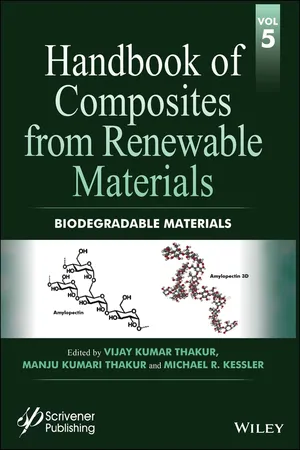
Handbook of Composites from Renewable Materials, Biodegradable Materials
- English
- ePUB (mobile friendly)
- Available on iOS & Android
Handbook of Composites from Renewable Materials, Biodegradable Materials
About this book
This unique multidisciplinary 8-volume set focuses on the emerging issues concerning synthesis, characterization, design, manufacturing and various other aspects of composite materials from renewable materials and provides a shared platform for both researcher and industry.
The Handbook of Composites from Renewable Materials comprises a set of 8 individual volumes that brings an interdisciplinary perspective to accomplish a more detailed understanding of the interplay between the synthesis, structure, characterization, processing, applications and performance of these advanced materials. The Handbook comprises 169 chapters from world renowned experts covering a multitude of natural polymers/ reinforcement/ fillers and biodegradable materials.
Volume 5 is solely focused on 'Biodegradable Materials'. Some of the important topics include but not limited to: Rice husk and its composites; biodegradable composites based on thermoplastic starch and talc nanoparticles; recent progress in biocomposites of biodegradable polymer; microbial polyesters: production and market; biodegradable and bioabsorbable materials for osteosynthesis applications; biodegradable polymers in tissue engineering; composites based on hydroxyapatite and biodegradable polylactide; biodegradable composites; development of membranes from biobased materials and their applications; green biodegradable composites based on natural fibers; fully biodegradable all-cellulose composites; natural fiber composites with bioderivative and/or degradable polymers; synthetic biodegradable polymers for bone tissue engineering; polysaccharides as green biodegradable platforms for building up electroactive composite materials; biodegradable polymer blends and composites from seaweeds; biocomposites scaffolds derived from renewable resources for bone tissue repair; pectin-based composites; recent advances in conductive composites based on biodegradable polymers for regenerative medicine applications; biosynthesis of PHAs and their biomedical applications; biodegradable soy protein isolate/poly(vinyl alcohol) packaging films; and biodegradability of biobased polymeric materials in natural environment.
Frequently asked questions
- Essential is ideal for learners and professionals who enjoy exploring a wide range of subjects. Access the Essential Library with 800,000+ trusted titles and best-sellers across business, personal growth, and the humanities. Includes unlimited reading time and Standard Read Aloud voice.
- Complete: Perfect for advanced learners and researchers needing full, unrestricted access. Unlock 1.4M+ books across hundreds of subjects, including academic and specialized titles. The Complete Plan also includes advanced features like Premium Read Aloud and Research Assistant.
Please note we cannot support devices running on iOS 13 and Android 7 or earlier. Learn more about using the app.
Information
Chapter 1
Rice Husk and its Composites: Effects of Rice Husk Loading, Size, Coupling Agents, and Surface Treatment on Composites’ Mechanical, Physical, and Functional Properties
Abstract
1.1 Introduction
| Fibers | Regions/countries of origin |
| Flax | Borneo |
| Hemp | Former Yugoslavia, China |
| Sun hemp | Nigeria, Guyana, Sierra Leone, India |
| Ramie | Honduras, Mauritius |
| Jute | India, Egypt, Guyana, Jamaica, Ghana, Malawi, Sudan, Tanzania |
| Kenaf | Iraq, Tanzania, Jamaica, South Africa, Cuba, Togo |
| Roselle | Borneo, Guyana, Malaysia, Sri Lanka, Togo, Indonesia, Tanzania |
| Sisal | East Africa, Bahamas, Antigua, Kenya, Tanzania, India |
| Abaca | Malaysia, Uganda, Philippines, Bolivia |
| Coir | India, Sri Lanka, Philippines, Malaysia |
| Rice husk | Asia, Pacific rim, North America |
Fiber | Cellulose (wt%) | Hemicellulose (wt%) | Lignin (wt%) | Pectin (wt%) | Wax (wt%) | Moisture content (wt%) |
| Wood | 40–50 | 15–25 | 15–30 | – | – | 8–16 |
| Jute | 61–71.5 | 13.6–20.4 | 12–13 | 0.4 | 0.5 | 12.6 |
| Hemp | 70.2–74.4 | 17.9–22.4 | 3.7–5.7 | 0.9 | 0.8 | 10 |
| Kenaf | 31–39 | 21.5 | 15–19 | – | – | – |
| Flax | 71 | 18.6–20.6 | 2.2 | 2.3 | 1.7 | 10 |
| Sisal | 67–78 | 10–14.2 | 8–11 | 10 | 2.0 | 11 |
| Coir | 36–43 | 10–20 | 41–45 | 3–4 | – | 8 |
| Bamboo | 26–49 | 15–27.7 | 21–31 | – | – | – |
Table of contents
- Cover
- Title page
- Copyright page
- Dedication
- Chapter 1: Rice Husk and its Composites: Effects of Rice Husk Loading, Size, Coupling Agents, and Surface Treatment on Composites’ Mechanical, Physical, and Functional Properties
- Chapter 2: Biodegradable Composites Based on Thermoplastic Starch and Talc Nanoparticles
- Chapter 3: Recent Progress in Biocomposite of Biodegradable Polymer
- Chapter 4: Microbial Polyesters: Production and Market
- Chapter 5: Biodegradable and Bioabsorbable Materials for Osteosynthesis Applications: State-of-the-Art and Future Perspectives
- Chapter 6: Biodegradable Polymers in Tissue Engineering
- Chapter 7: Composites Based on Hydroxyapatite and Biodegradable Polylactide
- Chapter 8: Biodegradable Composites: Properties and Uses
- Chapter 9: Development of Membranes from Biobased Materials and Their Applications
- Chapter 10: Green Biodegradable Composites Based on Natural Fibers
- Chapter 11: Fully Biodegradable All-Cellulose Composites
- Chapter 12: Natural Fiber Composites with Bioderivative and/or Degradable Polymers
- Chapter 13: Synthetic Biodegradable Polymers for Bone Tissue Engineering
- Chapter 14: Polysaccharides as Green Biodegradable Platforms for Building-up Electroactive Composite Materials: An Overview
- Chapter 15: Biodegradable Polymer Blends and Composites from Seaweeds
- Chapter 16: Biocomposite Scaffolds Derived from Renewable Resources for Bone Tissue Repair
- Chapter 17: Pectin-Based Composites
- Chapter 18: Recent Advances in Conductive Composites Based on Biodegradable Polymers for Regenerative Medicine Applications
- Chapter 19: Biosynthesis of PHAs and Their Biomedical Applications
- Chapter 20: Biodegradable Soy Protein Isolate/Poly(Vinyl Alcohol) Packaging Films
- Chapter 21: Biodegradability of Biobased Polymeric Materials in Natural Environments
- Index
- End User License Agreement